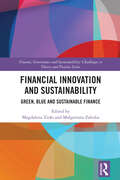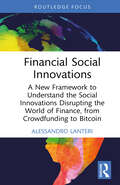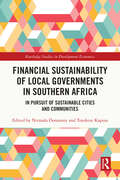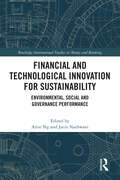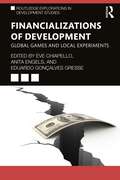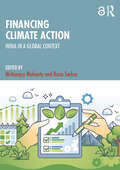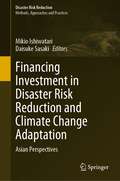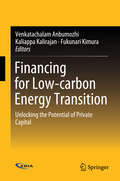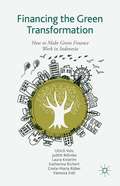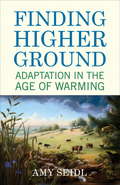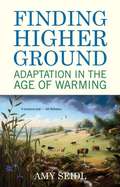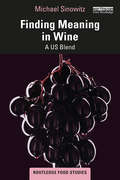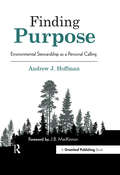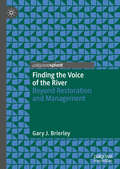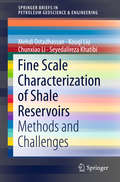- Table View
- List View
Financial Innovation and Sustainability: Green, Blue and Sustainable Finance (Finance, Governance and Sustainability)
by Magdalena Zioło Małgorzata ZaleskaIn recent years, factors such as sustainability, digitalization, climate change, energy transformation, social inclusion, gender parity, and Environmental, Social and Governance (ESG) risk have been playing an increasingly important role in the process of financial transformation. The effect of the impact is increased regulation and guidance for financial markets, in relation to adapting current activities to meet the new challenges, for example: The process of greening finance and spreading the blue wave in finance Building sustainable value in the business models of financial institutions Creating an offer of sustainable financial products Ensuring parity between women and men in the decision-making bodies of financial institutions Sustainable ratings Climate stress tests This book focuses on the intersection between nature and finance and offers a comprehensive overview of the trends, transformations and challenges in finance and the financial markets related to the effects of sustainability concepts or ESG factors. The book has been designed to show these trends, through the evolving subdisciplines of finance, such as green and blue finance. It presents critical recommendations for the ecosystem and network of finance in the era of ESG and sustainability and paints a comprehensive picture of contemporary finance, identifying the factors determining its sustainable transformation.This is one of the first books to present the issues of sustainability and ESG risk in finance through the prism of individual types of finance. Not only will the book appeal to scholars and researchers in the field of banking, economics, finance and accounting, but it will also find an audience among policymakers and practitioners involved in the finance and sustainability discourse.
Financial Social Innovations: A New Framework to Understand the Social Innovations Disrupting the World of Finance, from Crowdfunding to Bitcoin
by Alessandro LanteriThis book helps make sense of the emerging and established social innovations that have disrupted and are disrupting the world of finance.Written in an engaging style, this book offers a systematic study of social innovation in the financial services. It introduces the fundamental concepts of financial social innovations (FINSIs), places them in the context of the broader literature, and provides a new framework for understanding and organising these innovations. The book applies the framework to seven existing FINSIs to illustrate their important components and explore their benefits as well as the more negative or harmful aspects to society. These seven FINSIs are microfinance, peer-to-peer (P2P) lending, crowdfunding, mobile banking, impact investing, digital cryptocurrencies, and social impact bonds. The easy-to-follow framework will help to ground the reader’s understanding of FINSIs as the existing ones evolve and new ones are developed.This book is ideal for courses on social innovation, social entrepreneurship, and financial innovation in departments of business, economics, social sciences, and political science.
Financial Stability, Economic Growth and Sustainable Development (Routledge Studies in the European Economy)
by Marc Baudry Sławomir Ireneusz Bukowski Marzanna Barbara LamentFollowing multiple global crises, there is an urgent need to review our economic and financial paradigms to improve outcomes for the three pillars of sustainable development: economic, social, and environmental. In response, various strands of new economic thinking have emerged such as degrowth, the collaborative economy, solidarity economy, sharing economy and social entrepreneurship. This book explores the various economic and financial dimensions of sustainable development drawing on new and existing theories.This comprehensive book is divided into four sections, each presenting the results of a team of international researchers, tackling the issue from a global, macroeconomic, and microeconomic approach. The first part examines the determinants of sustainable development in the global economy, while the second looks at enterprise in a sustainable world. The third section analyses the financial markets and the fourth addresses economic policy and sustainable development. A wide array of sustainability concerns are discussed in-depth, from analysing changes in environmental social, and governance reporting and assessing their impact on the information systems and reporting of economic entities; exploring the transition to 'Industry 5.0', and how technological innovation can be deployed to support a better fit and 'win-win' interaction between industry and society, shifting focus from economic and technological factors to important environmental and social dimensions.The monograph is an invaluable resource for scholars, researchers, and students of applied, development, growth, resource, and welfare economics. The policy recommendations will be of benefit to policymakers concerned with issues of sustainable development generally and the Sustainable Development Goals specifically.
Financial Sustainability of Local Governments in Southern Africa: In Pursuit of Sustainable Cities and Communities (Routledge Studies in Development Economics)
by Nirmala Dorasamy Tonderai KapesaThis book delves into the critical issue of ensuring the long-term financial viability of local governments in the diverse region of Southern Africa. Across Southern Africa, cities and communities are facing a multitude of challenges, from rapid urbanization and infrastructure challenges to social inequality and environmental degradation. In this thought-provoking book, the authors explore the intricate relationship between financial sustainability and the pursuit of sustainable cities and communities through different lenses.Drawing on extensive research and case studies from various countries in the region, this book provides a comprehensive analysis of the financial realities faced by local governments. It examines the factors influencing revenue generation, expenditure management, and fiscal governance, shedding light on the complexities of financial decision-making in the context of limited resources and pressing development needs. Furthermore, it offers practical insights and actionable recommendations for policymakers, practitioners, and academics. It explores innovative approaches to revenue diversification, efficient expenditure allocation, and effective fiscal management, with the ultimate aim of fostering sustainable development, social services delivery, and environmentally sustainable infrastructure in Southern African cities and communities.This is an essential resource for anyone interested in understanding the challenges and opportunities associated with financial sustainability in the context of urbanisation and sustainable development in greater Africa. It serves as a guide and inspiration for building financially resilient local governments that can support the aspirations and well-being of their citizens while contributing to the broader vision of sustainable cities and communities.
Financial and Technological Innovation for Sustainability: Environmental, Social and Governance Performance (Routledge International Studies in Money and Banking)
by Artie Ng Jatin NathwaniThe COVID-19 crisis has proven that sustainability of an institution or organization requires a constant review of one’s strategic positioning and the execution of pertinent plans in response to evolving externalities. Resilient organizations continue to revive themselves through effective R&D and the renewal of their range of products and services. Financial and Technological Innovation for Sustainability: Environmental, Social and Governance Performance examines approaches to sustainability under the ongoing development of energy sustainability and the green finance initiatives. It unveils global heterogeneous efforts in achieving Environmental Social Governance (ESG) performance in light of climate change, global sustainability and concerns over corporate “greenwashing”. The book assembles a wealth of case studies from a variety of contemporary organizations that actively pursue sustainable development while seeking their next economic growth. These global cases demonstrate the salience of governance that institutes continuous advancements to enable the timely revitalization of corporate strategies, technological innovation and deployment of financial resources for sustainability transformation regardless of their stages of lifecycle. They reveal distinct approaches to financial and technological innovation in Africa, Asia, Europe and North America in pursuing the shared UN Sustainable Development Goals. The intertwined public-private partnership and implications of geopolitics under an evolving global financial system for sustainability transformation are articulated. This book will appeal to academics as well as business and finance professionals, who are keen to understand the interrelationship between financial and technological innovation, and to those who want to comprehend the underlying global challenges and opportunities of adopting emerging technologies to reinvent a business model that forges measurable and impactful ESG performances.
Financializations of Development: Global Games and Local Experiments (Routledge Explorations in Development Studies)
by Ève Chiapello Anita Engels Eduardo Gonçalves GresseFinancializations of Development brings together cutting-edge perspectives on socio-political, socio-historical and institutional analyses of the evolving multiple and intertwined financialization processes of developmental institutions, programs and policies. In recent years, the development landscape has seen a radical transformation in the partaking actors, which have moved beyond just multilateral or bilateral public development banks and aid agencies. The issue of financing for sustainable development is now at the top of the agenda for multilateral development actors. Increasingly, development institutions aim to include private actors and to lever in private money to support development projects. Drawing on case studies conducted in Africa, Asia, Europe and Latin America, this book examines the ways in which these private finance actors are enrolled and associated with the conception and implementation of development policies. Beginning with a focus on global actors and private foundations, this book considers the ways in which development funding is raised, managed and distributed, as well as debates at the center of global forums where financialized policies and solutions for development are conceived or discussed. The book assembles empirical research on development programs and demonstrates the social consequences of the financializations of development to the people on the ground. Highlighting the plurality of processes and outcomes of modern-day relations, tools, actors and practices in financing development around the world, this book is key reading for advanced students, researchers and practitioners in all areas of finance, development and sustainability.
Financing Climate Action: India in a Global Context
by Runa Sarkar Mritiunjoy MohantyThe urgency of mitigating climate change is mounting globally, and developing countries have a key role to play in ensuring a sustainable future. This book provides a comprehensive overview of all aspects of climate finance from the perspective of developing economies, with a focus on India.Catalysing climate action requires economic and societal adjustments, beginning with additional resource mobilisation, capital reallocation and financing structures supported by appropriate regulations, reasonably functioning markets and effective institutions. Through an integrated assessment of macro-financial policies and market microstructures, this book provides a thorough understanding of how countries in the Global South can effectively mobilise and deploy financial resources to address climate change challenges. It brings together the views of academics, bureaucrats, policy analysts and civil society organisations that are actively engaged in climate finance to discuss challenges and options for India as it seeks to finance effective climate action. It offers a plurality of often-opposing ideas and observations, rooted in the reality of India’s political economy. The volume presents novel solutions as well as lessons from international experiences to initiate and accelerate the flow of finance into climate related activities.This book will be an essential resource for scholars in environmental studies, development economics, and public policy, while offering crucial insights for policymakers and practitioners engaged in sustainable finance.This book is freely available as a downloadable Open Access PDF at http://www.taylorfrancis.com under a Creative Commons (CC-BY-NC-ND) 4.0 license.
Financing Investment in Disaster Risk Reduction and Climate Change Adaptation: Asian Perspectives (Disaster Risk Reduction)
by Mikio Ishiwatari Daisuke SasakiAs the population is growing and urbanization is progressing, higher numbers of people are exposed to disaster risks, especially in the developing countries. Climate change is further worsening the impacts of existing risks and introducing new ones. It is imperative that countries need to invest more in disaster risk reduction (DRR) as well as climate change adaptation (CCA) not only to minimize their impacts but also to build resilience.To date, various international arenas have recommended increasing investment in DRR. The Sendai Framework for DRR, adopted by the UN member states in 2015 during the Third UN World Conference on DRR, emphasizes investment as a priority for decreasing disaster risks and losses. The Yangon Declaration set the goal of doubling investment to address water-related disasters. However, most countries are not able to proactively invest enough in DRR. Understanding the current scale and estimate of investment and its effects is crucial for promoting DRR investment, but such information and estimates are rarely available.This book examines the current investment trends and issues in DRR and CCA. Based on specific case studies, field data and evidence, the book identifies challenges in increasing investment and recommends various investment policies and innovative approaches to sustainable progress towards a resilient future.Chapter 12 is available open access under a Creative Commons Attribution 4.0 International License via link.springer.com.
Financing Our Foodshed: Growing Local Food with Slow Money
by Carol Peppe Hewitt“[Hewitt] paints an engaging portrait of a community learning how to take care of its own, and offers inspiration for others looking to do the same.” —Amy Cortese, author of LocavestingIn towns and cities across North America, a quiet revolution is underway. Fed up with sending their money off to make a fast buck in faraway markets, people are putting their money to work where they live, in markets they trust and understand—starting with food.Financing Our Foodshed is a collection of real-life stories of these Slow Money pioneers and the local food entrepreneurs—sustainable farmers, bakers, restaurateurs, and more—they have chosen to support.Fueled by their desire to do more than just eat local food, lenders of “nurture capital” are making low-interest, peer-to-peer loans to the people who produce, process, distribute and sell local food. Meet these passionate food entrepreneurs like:Abi, talented artist-turned-baker, who borrowed the funds to start a gluten-free bakeryAngelina, owner of a Greek local foods restaurant, who refinanced exorbitant credit card debt incurred by renovationsChatham Marketplace, a much-loved grocery co-op whose monthly loan payments were reduced by a third, thanks to an ambitious collaboration between 16 investorsFinancing Our Foodshed tells the compelling stories of ordinary people doing something extraordinary, and will appeal to anyone who understands the critical importance of sustainably grown local food and resilient local economies, and wants a blueprint to get us there.“For anyone seriously interested in boosting his or her community’s economy—including politicians, policymakers, financiers, businesspeople, and activists—this book is essential reading.” —Michael H. Shuman, author of Put Your Money Where Your Life Is
Financing Sustainable Development: Key Challenges and Prospects (Palgrave Studies in Impact Finance)
by Bruno S. Sergi Magdalena ZioloThis book is among the first to address the issue of assessing the efficiency of sustainable development financing from a theoretical and methodical point of view. The innovative nature of research is expressed through the study of new phenomena in finance including sustainable financial systems, sustainable finance, ESG risk and individual and institutional motivations of financial managers in the sustainability concept. The book aims to draw attention to the significant gap in the existing research.The concept of Sustainable Development, if placed in an economic category, requires a lot of attention, but seeing the cognitive category from the perspective of the discipline of finance, the latter is unsatisfactory, with questions remaining unanswered. At the same time, the rank problem, its strategic dimension and the amount of financial resources allocated and disbursed for the purposes of focusing around sustainable development, identification of financial phenomena accompanying this category is seen as a priority. Most measures financing Sustainable Development and measures of public spending efficiency are measures subject to rigor and rules due to their specificity, which means actions aimed at increasing efficiency are treated as a priority. This book will be of interest to leading representatives of academia, practitioners, executives, officials, and graduate students in economics, finance, management, statistics, law and political sciences.
Financing for Low-carbon Energy Transition: Unlocking the Potential of Private Capital
by Venkatachalam Anbumozhi Kaliappa Kalirajan Fukunari KimuraThis book is the first comprehensive assessment of the state of low-carbon investments in Asia, analyzing the rationales, mandates and public–private financing activities. Based on the experiences of several regional initiatives wherein public financing is catalyzing private investments in low-carbon infrastructure, this book proposes a framework that can be used as a tool to identify factors that influence private investment decisions and policy instruments that can scale up the private capital.Placing the Asian economies onto a low-carbon development pathway requires an unprecedented shift in investments. This book addresses this situation by asking questions such as: • What is the central role of private finance in achieving the Paris Agreement targets? • What key policy levers and risk mitigation can governments use in an effort to unlock the potentials of private capital? • How can regionally coordinated actions hold significant promise for scaling up private investments?
Financing the Green Transformation
by Ulrich Volz Judith Böhnke Vanessa Eidt Laura Knierim Katharina Richert Greta-Maria RoeberPlanetary boundaries and a scarcity of natural resources will require a significant boost of investment into clean and renewable energy and a more efficient use of resources in developing, emerging and advanced economies alike. In this context, the financial sector will have to play a key role in providing 'green finance' for sustainable investment and development. Against this backdrop, this book investigates the challenges for developing and emerging economies in enhancing green financingfor sustainable, low-carbon investment, using Indonesia as a case study. Based on surveys in the Indonesian banking and corporate sectors and expert interviews, the book devises innovative policy recommendations for governments to develop a framework conducive to fostering green investments.
Find the Constellations
by H.A. ReyA classic for all ages—the &“wonderful&” guide to the night sky by the creator of Curious George (Horn Book). Containing star charts, a guide to the constellations, and details about seasons and the movement of the objects we see in the sky, this classic book makes H. A. Rey&’s passion for astronomy evident on every page. New updates concentrate on the planetary and solar system information in the latter part of the book. Facts and figures for each planet have been revised, and new scientific information has been added, such as Pluto&’s reclassification as a dwarf planet. There's also a brand-new online resource that allows readers to track the positions of the planets in the night sky till the year 2100. &“An excellent introduction to the heavens, to satisfy and stimulate a child&’s interest…a very useful book.&”—Kirkus Reviews &“Persuades the reader that astronomy is not only easy—it&’s fun.&”—The New York Times &“Excellent.&”—Saturday Review
Finding Chika: A heart-breaking and hopeful story about family, adversity and unconditional love
by Mitch AlbomFROM THE MASTER STORYTELLER WHOSE BOOKS HAVE TOUCHED THE HEARTS OF OVER 40 MILLION READERS'Mitch Albom sees the magical in the ordinary' Cecilia Ahern__________Chika Jeune came into Mitch Albom's life by chance. Growing up in the aftermath of the devastating 2010 Haiti Earthquake, at three years old she tragically lost her mother and was brought to the orphanage run by Mitch and his wife, Janine. Chika made a quick impression. Brave and self-assured, she delighted those around her. But everything changed when Chika was diagnosed with a terminal disease that no doctor in Haiti could treat. This discovery sparked a two-year, around-the-world journey in search of a cure. As Chika's boundless optimism and humour taught Mitch the joys of caring for a child, he learned that a relationship built on love can never be lost.__________WHAT READERS ARE SAYING ABOUT FINDING CHIKA'A powerful, emotional story''If you read one book this year, make it this one!''A beautifully written book, heart-breaking and uplifting in equal measure''An amazing journey of determination and love''I laughed, I cried, and just couldn't put it down'
Finding Chika: A heart-breaking and hopeful story about family, adversity and unconditional love
by Mitch AlbomChika Jeune was born three days before the devastating earthquake that decimated Haiti in 2010. She spent her infancy in extreme poverty, and when her mother died giving birth to a baby brother, Chika was brought to the Have Faith Haiti Orphanage that Mitch and his wife, Janine operate.Chika's arrival made a quick impression. Brave and self-assured, even as a three-year-old, she delighted the other kids and teachers. But at age five, Chika was suddenly diagnosed with a terminal disease that no doctor in Haiti could help with.Mitch and Janine took Chika to America, hoping that treatment there would enable her to go back home. Instead, Chika became a permanent part of their lives, as they embarked on a two-year, around-the-world journey to find a cure. As Chika's boundless optimism and humour taught Mitch the joys of caring for a child, he learnt that a relationship built on love, no matter what blows it takes, can never be lost.This is Mitch Albom at his most poignant, powerful and personal. Chika is a celebration of a girl, her adoptive guardians, and the incredible bond they formed - a devastatingly beautiful portrait of what it means to be a family, regardless of how it is made.
Finding Higher Ground
by Amy SeidlWhile much of the global warming conversation rightly focuses on reducing our carbon footprint, the reality is that even if we were to immediately cease emissions, we would still face climate change into the next millennium. In Finding Higher Ground, Amy Seidl takes the uniquely positive--yet realistic--position that humans and animals can adapt and persist despite these changes. Drawing on an emerging body of scientific research, Seidl brings us stories of adaptation from the natural world and from human communities. She offers examples of how plants, insects, birds, and mammals are already adapting both behaviorally and genetically. While some species will be unable to adapt to new conditions quickly enough to survive, Seidl argues that those that do can show us how to increase our own capacity for resilience if we work to change our collective behavior. In looking at climate change as an opportunity to establish new cultural norms, Seidl inspires readers to move beyond loss and offers a refreshing call to evolve.From the Hardcover edition.
Finding Higher Ground: Adaptation in the Age of Warming
by Amy SeidlAn ecologist takes the uniquely positive--yet realistic--position that we can adapt and persist despite the inevitable effects of climate change. While much of the global warming conversation rightly focuses on reducing our carbon footprint, the reality is that even if we were to immediately cease emissions, we would still face climate change into the next millennium. In Finding Higher Ground, Amy Seidl takes the uniquely positive--yet realistic--position that humans and animals can adapt and persist despite these changes. Drawing on an emerging body of scientific research, Seidl brings us stories of adaptation from the natural world and from human communities. She offers examples of how plants, insects, birds, and mammals are already adapting both behaviorally and genetically. Within ten years, one plant species in a drought-stricken area has evolved to fit its life cycle into the shorter growing season. Red squirrels are breeding earlier to take advantage of the food supplied by an earlier spring. And some birds are migrating shorter distances, or not at all, as their northern habitats become milder. While some species will be unable to adapt to new conditions quickly enough to survive, Seidl argues that those that do can show us how to increase our own capacity for resilience. She tells of a young farmer experimenting with adaptive strategies for local crops, architects using biomimicry to design buildings that actually contribute to their surrounding ecosystems, and the establishment of decentralized and renewable energy banks. While Seidl admits that these efforts alone won't change the world, she hopes that taken together they can form the basis for a new, revolutionary set of ideas to live by, much like the efforts that brought about abolition, women's suffrage, and the eight-hour workday. In looking at climate change as an opportunity to establish new cultural norms, Seidl's perspective inspires readers to move beyond loss and offers a refreshing call to evolve.
Finding Meaning in Wine: A US Blend (Routledge Food Studies)
by Michael SinowitzThis book examines controversies in American wine culture and how those controversies intersect with and illuminate current academic and cultural debates about the environment and about interpretation. With a specific focus on the United States of America, the methods that we use to discuss literature and other art are applied to wine-making and wine culture. The book explores the debates about how to evaluate wine and the problems inherent in numerical scoring as well as evaluative tasting notes, whether winemakers can be artists, the discourse in wine culture involving natural wine and biodynamic farming, as well as how people judge what makes a wine great. These interpretative commitments illuminate an underlying metaphysics and allegiance to a culture of reason or feeling. The discussions engage with a broad range of writers and thinkers, such as Roland Barthes, Susan Sontag, Louis Menand, Michael Pollan, Greg Garrard, John Guillory, Amitov Ghosh, Pierre Bourdieu, and Barbara Herrnstein-Smith. The book draws upon not only a number of texts produced by wine critics, wine writers, literary critics and theorists but also extensive interviews with wine writers and multiple California winemakers. These interviews contribute to a unique reflection on wine and meaning. This book will be of great interest to readers looking to learn more about wine from cultural, literary, and philosophical perspectives.
Finding Purpose: Environmental Stewardship as a Personal Calling
by Andrew J. HoffmanBoth thoughtful and thought-provoking, Finding Purpose aims to challenge our understanding of how humanity interacts with planet Earth, and our role within this. This book is an invitation: would you like to participate in one of the most important projects of imagination, perhaps the greatest ever, in human history? Distilling and refining over 20 pieces from a lifetime of work in academia and trade, across speeches, blogs, editorials and essays, Hoffman invites us to look beyond material growth and explore the role of the individual and business in discovering a wider purpose to bring about a balanced and sustainable society. The reader is encouraged to consider humanity’s relationship with the environment through different lenses: business, academia, faith-based and cultural. By bringing them together, Hoffman encourages us to understand our relationship with the planet in a far more holistic sense. Drawing on ideas from philosophy, literature, natural sciences and politics, Hoffman ensures that the ideas he explores are wholly accessible and applicable. Fully substantiated through various research and examples, the issues described are consistently made relevant to the reader.Finding Purpose is the perfect book for anyone – from student to CEO – thinking about their place in the world, and how making changes in our own lives and societies can impact on the world around us.
Finding Solutions of the 21st Century Transportation Problems Through Research and Innovations: Proceedings of the 6th GeoChina International Conference on Civil & Transportation Infrastructures: From Engineering to Smart & Green Life Cycle Solutions -- Nanchang, China, 2021 (Sustainable Civil Infrastructures)
by Musharraf Zaman Zahid Hossain Jiupeng ZhangThis volume presents challenges in transportation infrastructures and geotechniques, advancements in recycling, soil stabilization and reinforcement technologies, and assessments of roadway conditions using modern tools and techniques. The articles presented in this volume focus on fundamental investigations on various aspects of civil engineering materials and structures. The scope of this volume is the application of findings for solving problems in geotechnical, pavement, concrete and transportation engineering using through smart, green and emerging techniques. The primary audience of this work will be researchers, professionals, and practitioners around the world. This volume is based on contributions to the 6th GeoChina International Conference on Civil & Transportation Infrastructures: From Engineering to Smart & Green Life Cycle Solutions -- Nanchang, China, 2021.
Finding the Voice of the River: Beyond Restoration and Management
by Gary J. BrierleyThis book addresses societal relationships to river systems, highlighting many unexplored possibilities in how we know and manage our rivers. Brierley contends that although we have good scientific understanding of rivers, with remarkable prospect for profound improvements to river condition, management applications greatly under-deliver. He conceptualizes approaches to river repair in two very different ways: Medean (competitive) and Gaian (cooperative). Rather than ‘managing’ rivers to achieve particular anthropogenic goals (the former option), this book adopts a more-than-human approach to ‘living with living rivers’ (the latter option), applying a river rights framework that conceptualizes rivers as sentient entities.Chapters build on significant experience across many parts of the world, emphasizing the diverse array of river attributes and relationships to be protected and the wide range of problems to be addressed. Although the book has an environmental focus, it is framed as an argument in popular philosophy, contemplating the agency of rivers as place-beings. It will be of great value to academics, students and general readers interested in protecting river systems.
Fine Scale Characterization of Shale Reservoirs: Methods And Challenges (Springerbriefs In Petroleum Geoscience And Engineering Ser.)
by Mehdi Ostadhassan Kouqi Liu Chunxiao Li Seyedalireza KhatibiThis book summarizes the authors' extensive experience and interdisciplinary approach to demonstrate how acquiring and integrating data using a variety of analytical equipment can provide better insights into unconventional shale reservoir rocks and their constituent components. It focuses on a wide range of properties of unconventional shale reservoirs, discussing the use of conventional and new analytical methods for detailed measurements of mechanical properties of both organic and inorganic constituent elements as well as of the geochemical characteristics of organic components and their origins. It also addresses the investigation of porosity, pore size and type from several perspectives to help us to define unconventional shale formation. All of these analyses are treated individually, but brought together to present the rock sample on a macro scale. This book is of interest to researchers and graduate students from various disciplines, such as petroleum, civil, and mechanical engineering, as well as from geoscience, geology, geochemistry and geophysics. The methods and approaches can be further extended to biology and medicine.
Fingerprints of the Gods: The Evidence of Earth's Lost Civilization
by Graham HancockOn the great mysteries of nature, history, and man.
Fingerübungen der Physik: Repetitorium und Übungsbuch mit Lösungen und MATLAB-Programmen
by Michael Kaschke Holger CartariusDieses Lehr- und Lernbuch erscheint in mehreren Bänden und ist gleichsam ein Repetitorium als auch Arbeitsbuch zu wenig behandelten Kapiteln des Physikstudiums. In diesem Band wird die Physik der Bewegung von Körpern und des Kontinuums behandelt. Zahlreiche spannende Probleme aus dem Alltag, der Physikgeschichte und der modernen Forschung werden sowohl anschaulich erklärt als auch mathematisch-physikalisch beschrieben. Die ausführlichen Lösungsvorschläge mit MATLAB-Programmen dienen dabei als „Fingerübungen“ für ein tieferes physikalisches Verständnis. Der Inhalt Physik der Bewegung – Physik des Kontinuums Die Zielgruppe Das Buch richtet sich an alle, die Freude an der Physik haben und diese für verschiedene Fragestellungen anwenden wollen. Besonderen Nutzen daraus werden Studierende und Promovierende der Physik, Mathematik und Ingenieurswissenschaften, ebenso wie des Lehramtes für naturwissenschaftliche Fächer gewinnen. Genauso ist das Buch für Dozentinnen und Dozenten der Physik an Hochschulen und Universitäten gedacht, aber auch für Lehrkräfte der Physik an Gymnasien, die aus dem Fundus der Übungen und Beispiele Anregungen für eigene Problemstellungen und Projekte gewinnen können. Vorkenntnisse Das Physikwissen des Bachelor-Studiums stellt in etwa die Grundlage dar, auf der das Buch aufbaut. Eine Reihe von Kapiteln lassen sich auch mit den Kenntnissen eines Leistungskurses Physik an den Gymnasien erschließen. Die Übungsaufgaben sind nach 3 Schwierigkeitsklassen gegliedert.
Finite Difference Methods for Compressible Two-Fluid Dynamics (Forum for Interdisciplinary Mathematics)
by Khosro ShahbaziFinite Difference Methods for Compressible Two-Fluid Dynamics provides the essentials of high-order numerical methods for compressible single-fluid and two-fluid transport phenomena. This book can serve as a first course on the numerical methods for transport phenomena or fluid dynamics for students in mechanical, aerospace, and chemical engineering, applied mathematics, and physics at the senior level of an undergraduate or graduate degree. It also provides foundations and algorithmic details for implementing the most recent numerical schemes for compressible flows and extending them to include other physics, such as elasticity, reaction, and magnetohydrodynamics. The book's presented schemes enable computations for broad applications, including shock-induced interfacial instability and turbulence, shock-bubble interactions, and detonation, to name a few. For a broad reach and impact, the numerical schemes satisfy the simultaneous requirements of simplicity, extendibility, and efficiency on serial and parallel computers. The physics of the compressible single- and two-fluid system also guide the design and analysis of the numerical methods. The enabled direct numerical simulations also help obtain accurate data for tuning the emerging physics-based neuromorphic algorithms.
